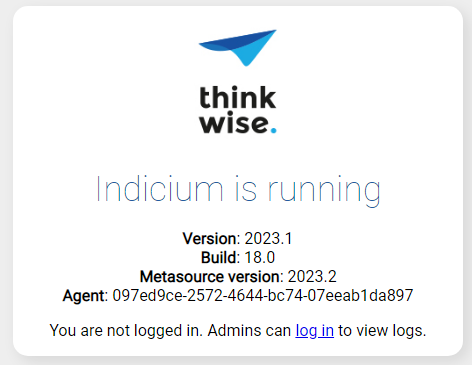I get the following error stating it can not make a connection to the database. Which is weird because I can login to the application and see the full menu. Just can't load the components.
I my .ENV I use a remote IP-adres and the IAM database.
I also tried disabling the entire firewall in front of the database server, didn't make a difference.
2023-09-27T14:51:54.4593861+00:00 0HMTVD4RTLBUJ:00000006 [ERR] An unhandled exception occurred while processing the request. (ffba027a)
Microsoft.Data.SqlClient.SqlException (0x80131904): A network-related or instance-specific error occurred while establishing a connection to SQL Server. The server was not found or was not accessible. Verify that the instance name is correct and that SQL Server is configured to allow remote connections. (provider: TCP Provider, error: 40 - Could not open a connection to SQL Server: Could not open a connection to SQL Server)
2023-09-27T14:51:54.4593861+00:00 0HMTVD4RTLBUJ:00000006 [ERR] An unhandled exception occurred while processing the request. (ffba027a)
Microsoft.Data.SqlClient.SqlException (0x80131904): A network-related or instance-specific error occurred while establishing a connection to SQL Server. The server was not found or was not accessible. Verify that the instance name is correct and that SQL Server is configured to allow remote connections. (provider: TCP Provider, error: 40 - Could not open a connection to SQL Server: Could not open a connection to SQL Server)
at Microsoft.Data.SqlClient.TdsParser.ThrowExceptionAndWarning(TdsParserStateObject stateObj, Boolean callerHasConnectionLock, Boolean asyncClose)
at Microsoft.Data.SqlClient.TdsParser.Connect(ServerInfo serverInfo, SqlInternalConnectionTds connHandler, Boolean ignoreSniOpenTimeout, Int64 timerExpire, SqlConnectionString connectionOptions, Boolean withFailover)
at Microsoft.Data.SqlClient.SqlInternalConnectionTds.AttemptOneLogin(ServerInfo serverInfo, String newPassword, SecureString newSecurePassword, Boolean ignoreSniOpenTimeout, TimeoutTimer timeout, Boolean withFailover)
at Microsoft.Data.SqlClient.SqlInternalConnectionTds.LoginNoFailover(ServerInfo serverInfo, String newPassword, SecureString newSecurePassword, Boolean redirectedUserInstance, SqlConnectionString connectionOptions, SqlCredential credential, TimeoutTimer timeout)
at Microsoft.Data.SqlClient.SqlInternalConnectionTds.OpenLoginEnlist(TimeoutTimer timeout, SqlConnectionString connectionOptions, SqlCredential credential, String newPassword, SecureString newSecurePassword, Boolean redirectedUserInstance)
at Microsoft.Data.SqlClient.SqlInternalConnectionTds..ctor(DbConnectionPoolIdentity identity, SqlConnectionString connectionOptions, SqlCredential credential, Object providerInfo, String newPassword, SecureString newSecurePassword, Boolean redirectedUserInstance, SqlConnectionString userConnectionOptions, SessionData reconnectSessionData, Boolean applyTransientFaultHandling, String accessToken, DbConnectionPool pool)
at Microsoft.Data.SqlClient.SqlConnectionFactory.CreateConnection(DbConnectionOptions options, DbConnectionPoolKey poolKey, Object poolGroupProviderInfo, DbConnectionPool pool, DbConnection owningConnection, DbConnectionOptions userOptions)
at Microsoft.Data.ProviderBase.DbConnectionFactory.CreatePooledConnection(DbConnectionPool pool, DbConnection owningObject, DbConnectionOptions options, DbConnectionPoolKey poolKey, DbConnectionOptions userOptions)
at Microsoft.Data.ProviderBase.DbConnectionPool.CreateObject(DbConnection owningObject, DbConnectionOptions userOptions, DbConnectionInternal oldConnection)
at Microsoft.Data.ProviderBase.DbConnectionPool.UserCreateRequest(DbConnection owningObject, DbConnectionOptions userOptions, DbConnectionInternal oldConnection)
at Microsoft.Data.ProviderBase.DbConnectionPool.TryGetConnection(DbConnection owningObject, UInt32 waitForMultipleObjectsTimeout, Boolean allowCreate, Boolean onlyOneCheckConnection, DbConnectionOptions userOptions, DbConnectionInternal& connection)
at Microsoft.Data.ProviderBase.DbConnectionPool.WaitForPendingOpen()
--- End of stack trace from previous location ---
at Indicium.Data.SQLServer.Helpers.TSFSqlConnectionHelper.createOpenedSqlConnection(DbConnectionInfo connectionInfo, IConnectionCredentials credentials, TSFApplication application, TSFUserContext userContext, TSFMessageHandler messageHandler) in C:\azp\agent\_work\1\s\src\Data\Indicium.Data.SQLServer\Helpers\TSFSqlConnectionHelper.cs:line 123
at Indicium.Data.SQLServer.Helpers.TSFSqlConnectionHelper.CreateOpenedSqlConnection(TSFApplication application, IConnectionCredentials credentials, TSFUserContext userContext, TSFMessageHandler messageHandler, Func`3 tsfSendProgressHandler) in C:\azp\agent\_work\1\s\src\Data\Indicium.Data.SQLServer\Helpers\TSFSqlConnectionHelper.cs:line 97
at Indicium.Shared.Telemetry.ServerTimings.ServerTimingsBuilder.Capture[T](String key, Func`1 action) in C:\azp\agent\_work\1\s\src\Indicium.Shared\Telemetry\ServerTimings\ServerTimingsBuilder.cs:line 62
at Indicium.Data.Shared.TSFDbDataProvider.GetDataReader(SelectQuery query) in C:\azp\agent\_work\1\s\src\Data\Indicium.Data.Shared\TSFDbDataProvider.cs:line 214
at Indicium.Shared.Telemetry.ServerTimings.ServerTimingsBuilder.Capture[T](String key, Func`1 action) in C:\azp\agent\_work\1\s\src\Indicium.Shared\Telemetry\ServerTimings\ServerTimingsBuilder.cs:line 62
at Indicium.Controllers.TableController.GetResourceSet(SelectQuery query, IEdmNavigationSource navigationTarget, HashSet`1 eagerFileColumns, List`1 resourceSelectColumns, String serverTimingName) in C:\azp\agent\_work\1\s\src\Indicium\Controllers\TableController.cs:line 247
at Indicium.Controllers.TableController.Get(Boolean requestedAsync) in C:\azp\agent\_work\1\s\src\Indicium\Controllers\TableController.cs:line 172
at Microsoft.AspNetCore.Mvc.Infrastructure.ActionMethodExecutor.TaskOfIActionResultExecutor.Execute(IActionResultTypeMapper mapper, ObjectMethodExecutor executor, Object controller, Object[] arguments)
at Microsoft.AspNetCore.Mvc.Infrastructure.ControllerActionInvoker.<InvokeActionMethodAsync>g__Logged|12_1(ControllerActionInvoker invoker)
at Microsoft.AspNetCore.Mvc.Infrastructure.ControllerActionInvoker.<InvokeNextActionFilterAsync>g__Awaited|10_0(ControllerActionInvoker invoker, Task lastTask, State next, Scope scope, Object state, Boolean isCompleted)
at Microsoft.AspNetCore.Mvc.Infrastructure.ControllerActionInvoker.Rethrow(ActionExecutedContextSealed context)
at Microsoft.AspNetCore.Mvc.Infrastructure.ControllerActionInvoker.Next(State& next, Scope& scope, Object& state, Boolean& isCompleted)
at Microsoft.AspNetCore.Mvc.Infrastructure.ControllerActionInvoker.<InvokeInnerFilterAsync>g__Awaited|13_0(ControllerActionInvoker invoker, Task lastTask, State next, Scope scope, Object state, Boolean isCompleted)
at Microsoft.AspNetCore.Mvc.Infrastructure.ResourceInvoker.<InvokeNextResourceFilter>g__Awaited|25_0(ResourceInvoker invoker, Task lastTask, State next, Scope scope, Object state, Boolean isCompleted)
at Microsoft.AspNetCore.Mvc.Infrastructure.ResourceInvoker.Rethrow(ResourceExecutedContextSealed context)
at Microsoft.AspNetCore.Mvc.Infrastructure.ResourceInvoker.Next(State& next, Scope& scope, Object& state, Boolean& isCompleted)
at Microsoft.AspNetCore.Mvc.Infrastructure.ResourceInvoker.<InvokeFilterPipelineAsync>g__Awaited|20_0(ResourceInvoker invoker, Task lastTask, State next, Scope scope, Object state, Boolean isCompleted)
at Microsoft.AspNetCore.Mvc.Infrastructure.ResourceInvoker.<InvokeAsync>g__Logged|17_1(ResourceInvoker invoker)
at Microsoft.AspNetCore.Mvc.Infrastructure.ResourceInvoker.<InvokeAsync>g__Logged|17_1(ResourceInvoker invoker)
at Microsoft.AspNetCore.Routing.EndpointMiddleware.<Invoke>g__AwaitRequestTask|6_0(Endpoint endpoint, Task requestTask, ILogger logger)
at Microsoft.AspNetCore.Authorization.AuthorizationMiddleware.Invoke(HttpContext context)
at Microsoft.AspNetCore.Authentication.AuthenticationMiddleware.Invoke(HttpContext context)
at Indicium.Extensions.ApplicationBuilderExtensions.<>c.<<SameSiteOpenIDConnectInterceptor>b__0_0>d.MoveNext() in C:\azp\agent\_work\1\s\src\Indicium\Extensions\ApplicationBuilderExtensions.cs:line 57
--- End of stack trace from previous location ---
at Microsoft.AspNetCore.Session.SessionMiddleware.Invoke(HttpContext context)
at Microsoft.AspNetCore.Session.SessionMiddleware.Invoke(HttpContext context)
at Microsoft.AspNetCore.ResponseCompression.ResponseCompressionMiddleware.InvokeCore(HttpContext context)
at Indicium.Middleware.Security.AuthenticationHeadersMiddleware.InvokeAsync(HttpContext context) in C:\azp\agent\_work\1\s\src\Indicium\Middleware\Authentication\AuthenticationHeadersMiddleware.cs:line 48
at Indicium.Middleware.Security.SecurityHeadersMiddleware.InvokeAsync(HttpContext context, ContentSecurityPolicyBuilder cspBuilder) in C:\azp\agent\_work\1\s\src\Indicium\Middleware\Security\SecurityHeadersMiddleware.cs:line 55
at Indicium.Middleware.Messages.TSFMessagesMiddleware.Invoke(HttpContext context, IRootApplicationLoader rootApplicationLoader, TSFRequestContext requestContext) in C:\azp\agent\_work\1\s\src\Indicium\Middleware\Messages\TSFMessageMiddleware.cs:line 45
at Indicium.Middleware.Telemetry.ServerTimings.ServerTimingsMiddleware.InvokeAsync(HttpContext context, ServerTimingsBuilder serverTimingsBuilder) in C:\azp\agent\_work\1\s\src\Indicium\Middleware\Telemetry\ServerTimings\ServerTimingsMiddleware.cs:line 43
at Indicium.Middleware.ExceptionHandlingMiddleware.Invoke(HttpContext context, TSFRequestContext requestContext) in C:\azp\agent\_work\1\s\src\Indicium\Middleware\ExceptionHandlingMiddleware.cs:line 87
ClientConnectionId:00000000-0000-0000-0000-000000000000



